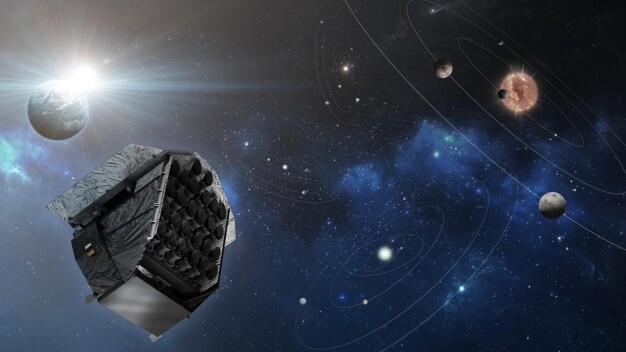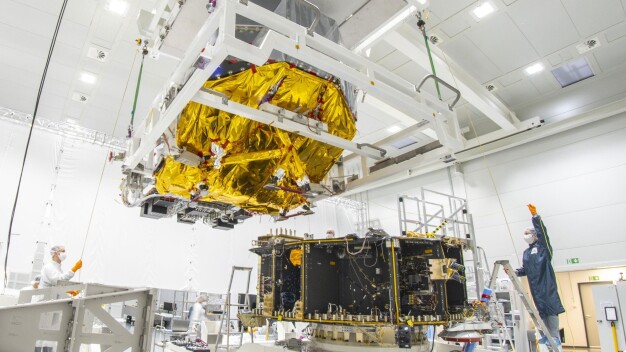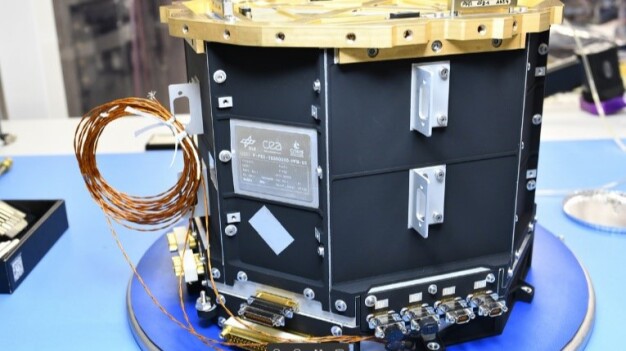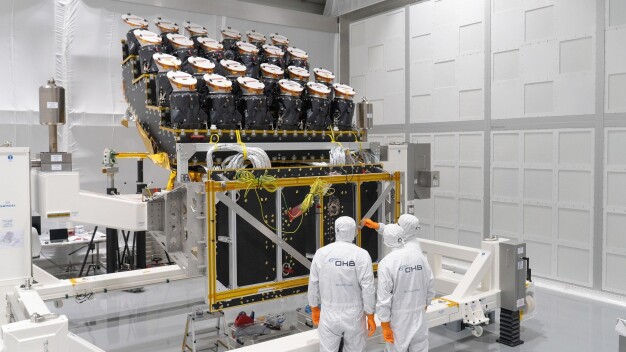- Science
ESA's PLATO space telescope integrated
Search for exoplanets
– ESA's PLATO space telescope is scheduled to launch at the end of 2026 and begin its search for Earth-like planets orbiting Sun-like stars in 2027.
– The telescope's optical bench, with its 26 cameras, has now been integrated into the spacecraft's service module – only the solar panels remain to be added.
– Germany is playing a major role in the construction, operation and scientific analysis of PLATO and its data.
– Focus: Spaceflight, space exploration, exoplanets
Are there planets similar to Earth? Do they orbit stars like our Sun? How do planetary systems form and evolve? To answer these and other questions, the European Space Agency (ESA) will launch the PLATO (PLAnetary Transits and Oscillations of stars) mission at the end of 2026. From 2027, it will begin its search for planets beyond our Solar System – with a particular focus on Earth-sized planets orbiting Sun-like stars. A major mission milestone has now been reached – from 10 to 13 June 2025, the telescope's two main components were integrated at the site of the aerospace and technology company OHB in Oberpfaffenhofen, Germany. Germany is significantly involved in the construction of the telescope, its operations and the scientific evaluation of its data. German contributions and the international science team are coordinated by the German Aerospace Center (Deutsches Zentrum für Luft- und Raumfahrt; DLR).
"Almost exactly eight years to the day since ESA gave the green light for the PLATO mission, both the satellite and its unique telescope with 26 'eyes' have been completed on schedule," explains Heike Rauer, scientific lead of the mission from DLR and Freie Universität Berlin. "This is an outstanding achievement. Unlike many other space telescopes, PLATO doesn't rely on just one complex telescope camera – it uses 26 cameras in total. They will enable PLATO to observe approximately 250,000 stars for any orbiting planets. The 26 sensitive cameras were built and tested in the member states of the payload consortium. The international cooperation between consortium members and ESA has worked exceptionally well. All tests completed so far suggest that PLATO will deliver the planned and required measurement accuracy."
Millimetre-level precision in the cleanroom
In the cleanroom of OHB System AG – the industrial prime contractor for PLATO – the 'optical bench' with its 26 cameras was mounted above the spacecraft's service module at the integration facility in Oberpfaffenhofen, Bavaria. The service module houses all the components required for spaceflight, control and telescope operations – including the propulsion system, the antenna for communicating with Earth and the systems for transmitting scientific data. Over the past few months, the 26 cameras have been mounted on the camera platform.
The platform was positioned and aligned with millimetre precision above the service module. The integration team then tested the electrical connections. Once all tests were successfully passed, the two satellite components were firmly connected. In the coming weeks, the satellite will undergo a full functionality test of both the space telescope and its data processing systems.
The next major step for PLATO is its transport from Oberpfaffenhofen to ESA's Space Research and Technology Centre (ESTEC) in Noordwijk, the Netherlands. There, PLATO will be fitted with its solar panels and sunshields, before being tested in a space simulation chamber. The spacecraft will then be shipped to the launch site in Kourou, French Guiana. It is scheduled to launch aboard an Ariane 6 rocket with two solid boosters in December 2026.
26 cameras scanning the Milky Way
With its unique design – 26 telescope cameras mounted on a shared platform instead of one large telescope mirror – PLATO will initially examine approximately 250,000 stars for orbiting planets. To do this, the probe will be steered to the second Lagrange point (L2), located 1.5 million kilometres from Earth, where the James Webb Space Telescope also resides. Scientists expect the mission to discover thousands of rocky, icy and gaseous planets orbiting various types of stars. To detect these worlds, PLATO will use the transit method – the same technique used in earlier exoplanet missions such as the French–European CoRoT mission and NASA's Kepler mission. This technique relies on measuring the regular, slight fluctuations ('dips') in the brightness of a star caused by a planet passing in front of it. These 'candidates' are then studied in more detail from Earth using ground-based telescopes.
What is Lagrange point 2?
Lagrange point 2 – L2 for short – is located 1.5 million kilometres from Earth, along the 'Sun-Earth line'. It's a location in space where the gravitational forces of Earth and the Sun balance each other out in such a way that a satellite can maintain a stable position there with minimal energy expenditure. L2 is particularly valuable for astronomy because space telescopes like PLATO and James Webb can operate there undisturbed by Earth's radiation, while maintaining an uninterrupted line of communication with Earth and a permanent view into deep space.
All 26 cameras share the same optical design, but the detectors operate at different readout speeds. Two 'fast' cameras read out their data every 2.5 seconds, while the 24 'normal' cameras operate at a rate of 25 seconds. Data from the fast cameras is used to precisely align PLATO and keep it on course. The normal cameras serve as the 'scientific workhorses' of the mission, recording the light curves from which potential planetary signals can be identified. PLATO will not take actual optical images of exoplanets – the kind of photos that can be taken of planets in our Solar System, as exoplanets are far too distant. Instead, the instruments will measure the periodic dimming and brightening of starlight, which may indicate the presence of a planet orbiting a star.
The highly sophisticated readout electronics and data processing systems for the fast cameras – including the software for precision alignment of the satellite – were developed at the DLR Institute of Space Research in Berlin-Adlershof. In addition to the rapid 2.5-second readout rate, the fast cameras have another special feature: they are equipped with either a blue or red filter. This makes it possible to record transit events at both shorter (blue) and longer (red) wavelengths. Differences in the transit signals between these wavelengths could indicate the presence of an atmosphere on the observed exoplanets.
German coordination for an ESA mission
PLATO's scientific payload is being developed and built by an international consortium involved in both the hardware and software components of the mission and operation of its data centre. The consortium is led by DLR. ESA is responsible for the entire mission, including construction of the telescope, the spacecraft launch, ground segment, mission control and operations. The Max Planck Institute for Solar System Research in Göttingen is responsible for the setup and coordination of the PLATO scientific data centre. Germany is also playing a major role in supporting the camera test campaigns, the development of data processing pipelines and the scientific analysis of mission data – carried out by the Freie Universität Berlin, Aachen University of Applied Sciences and the Rhenish Institute for Environmental Research (RIU) at the University of Cologne. Parts of the payload development, the data centre and payload operations from late 2026 onward will be financed by the German Space Agency at DLR with funds from the German Federal Government. The satellite carrying the payload will be built and assembled by the PLATO industrial core team, led by OHB, together with Thales Alenia Space and Beyond Gravity.
DLR e.V.
51147 Köln
Germany












